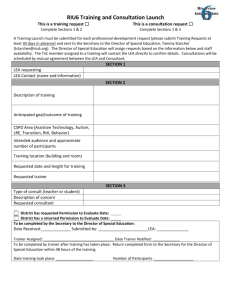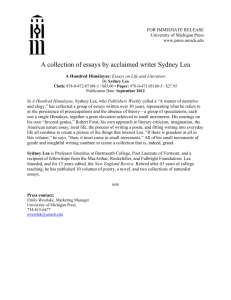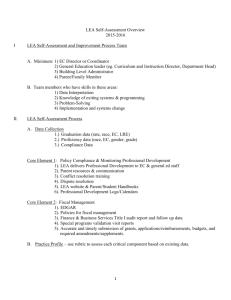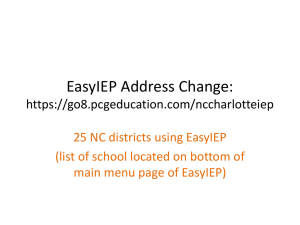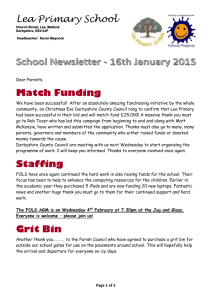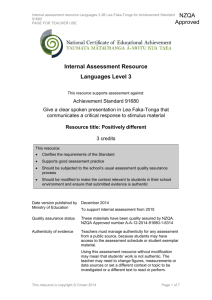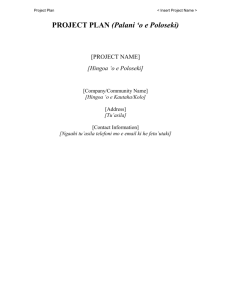Level 3 Languages internal assessment resource
advertisement
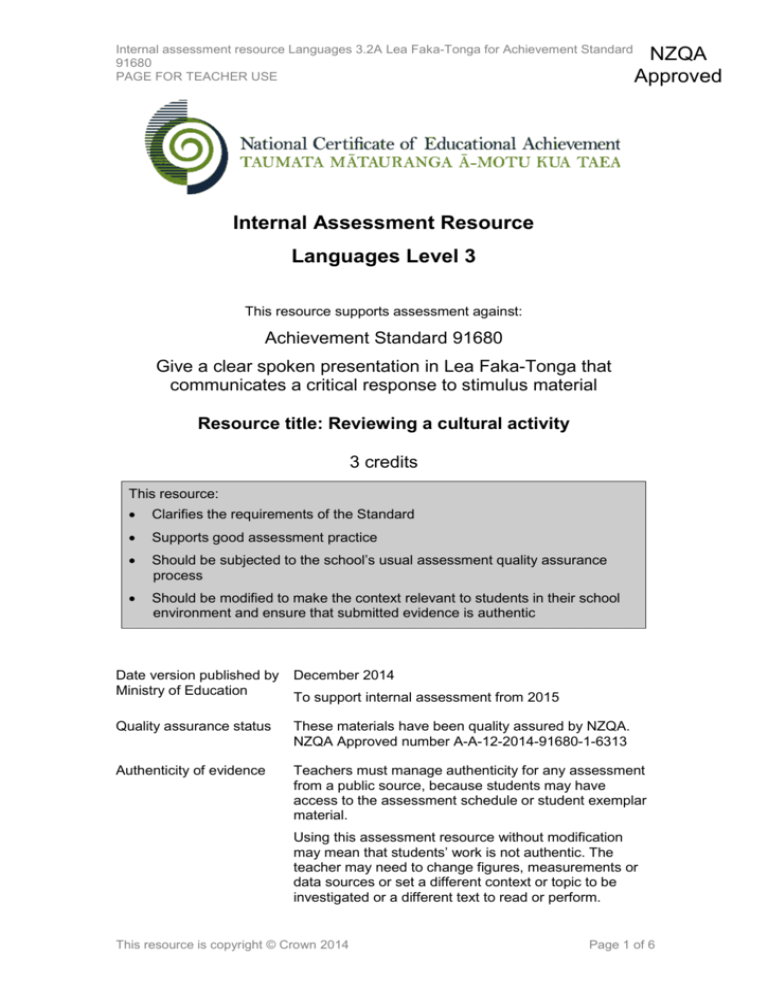
Internal assessment resource Languages 3.2A Lea Faka-Tonga for Achievement Standard 91680 PAGE FOR TEACHER USE NZQA Approved Internal Assessment Resource Languages Level 3 This resource supports assessment against: Achievement Standard 91680 Give a clear spoken presentation in Lea Faka-Tonga that communicates a critical response to stimulus material Resource title: Reviewing a cultural activity 3 credits This resource: Clarifies the requirements of the Standard Supports good assessment practice Should be subjected to the school’s usual assessment quality assurance process Should be modified to make the context relevant to students in their school environment and ensure that submitted evidence is authentic Date version published by Ministry of Education December 2014 Quality assurance status These materials have been quality assured by NZQA. NZQA Approved number A-A-12-2014-91680-1-6313 Authenticity of evidence Teachers must manage authenticity for any assessment from a public source, because students may have access to the assessment schedule or student exemplar material. To support internal assessment from 2015 Using this assessment resource without modification may mean that students’ work is not authentic. The teacher may need to change figures, measurements or data sources or set a different context or topic to be investigated or a different text to read or perform. This resource is copyright © Crown 2014 Page 1 of 6 Internal assessment resource Languages 3.2A Lea Faka-Tonga for Achievement Standard 91680 PAGE FOR TEACHER USE Internal Assessment Resource Achievement Standard Languages 91680: Give a clear spoken presentation in Lea Faka-Tonga that communicates a critical response to stimulus material Resource reference: Languages 3.2A Lea Faka-Tonga Resource title: Reviewing a cultural activity Credits: 3 Teacher guidelines The following guidelines are supplied to enable teachers to carry out valid and consistent assessment using this internal assessment resource. Teachers need to be very familiar with the outcome being assessed by Achievement Standard Languages 91680. The achievement criteria and the explanatory notes contain information, definitions, and requirements that are crucial when interpreting the Standard and assessing students against it. Context/setting This activity requires the student to give a clear oral presentation in which they review a school or class trip relating to a cultural activity, or another type of cultural activity that they have participated in. The school or class trip could be, for example, to the movies, a restaurant, a museum or art gallery exhibition, speciality shops, live performances, or a festival. The cultural activity could take place inside or outside the classroom and could include, for example, a cooking class, a guest speaker, craft making, or a festival celebration. The cultural activity could also take place within another curriculum area but it must be related to the Tongan culture. Ensure that the cultural activity chosen offers plenty of scope for students to engage with ideas in ways that are expected at level 8 of the curriculum. This resource material should be read in conjunction with: the Senior Secondary Teaching and Learning Guides for languages http://seniorsecondary.tki.org.nz/ NCEA Level 3 Languages Conditions of Assessment http://ncea.tki.org.nz/Resources-for-Internally-Assessed-Achievement-Standards Conditions This Standard assesses the student’s ability to speak in front of an audience and has effective communication as its focus. You will need to specify the amount of class time that the student has to prepare their presentation and allow class time for all of the students to give their presentations to their classmates. This resource is copyright © Crown 2014 Page 2 of 6 Internal assessment resource Languages 3.2A Lea Faka-Tonga for Achievement Standard 91680 PAGE FOR TEACHER USE The students may work in pairs or in groups for their initial preparation and brainstorming but they will give their presentations and be assessed individually. The presentations will be given in front of the class and recorded for assessment purposes. Provided a student’s presentation meets the communicative purpose of the task, the length may vary. A length of about two to three minutes is suggested. However, at all times quality is more important than length. Resource requirements Audio and video recording equipment. Additional information None. This resource is copyright © Crown 2014 Page 3 of 6 Internal assessment resource Languages 3.2A Lea Faka-Tonga for Achievement Standard 91680 PAGE FOR STUDENT USE Internal Assessment Resource Achievement Standard Languages 91680: Give a clear spoken presentation in Lea Faka-Tonga that communicates a critical response to stimulus material Resource reference: Languages 3.2A Lea Faka-Tonga Resource title: Reviewing a cultural activity Credits: 3 Achievement Give a clear spoken presentation in Lea FakaTonga that communicates a critical response to stimulus material. Achievement with Merit Give a clear, convincing spoken presentation in Lea Faka-Tonga that communicates a critical response to stimulus material. Achievement with Excellence Give a clear, effective spoken presentation in Lea FakaTonga that communicates a critical response to stimulus material. Student instructions Introduction This assessment activity requires you to give a clear oral presentation in Lea FakaTonga that reviews a Tongan cultural activity that you have taken part in. Teacher note: You will need to add information about the cultural activity the students will take part in. You will also need to let them know how their presentations will be recorded and stored. You may work in pairs or in groups for your initial preparation and brainstorming. But you will give your presentation and be assessed individually. You will give your presentation to your classmates in class time. You can use prepared notes, cue cards, props, photos, and other supporting material but you must not read directly from your notes. If you read directly from your notes, you will not meet the Standard. Your presentation must be your own work. If you include extracts from external sources, you must acknowledge those sources. Any extracts will not contribute towards your final grade. You may not use language from the language samples unless it has been significantly reworked. Your teacher will tell you how your presentation will be recorded and stored. The suggested length for your presentation is about two to three minutes. However, quality is more important than quantity. You will be assessed on how effectively you communicate your response to the cultural activity. This resource is copyright © Crown 2014 Page 4 of 6 Internal assessment resource Languages 3.2A Lea Faka-Tonga for Achievement Standard 91680 PAGE FOR STUDENT USE Task Prepare and give a clear spoken presentation in Lea Faka-Tonga in which you review a Tongan cultural activity that you have participated in. Your review must be more than a description of what you saw or what happened: “a critical response” will include analysis, interpretation, or evaluation. Whether you are expressing your own viewpoint or supporting or challenging the ideas or opinions of others, explain and justify your thinking. In your presentation you could include, for example: a description of the cultural activity (who, when, where, what) your impressions and reactions (how you felt and what you thought before, during, after the activity) what you have learnt on a personal level from the experience (for example, has it challenged you or led to a change of opinion?) a comparison between cultural elements in the activity and relevant aspects of your own culture some ideas and information from sources other than your own direct experience a critical evaluation of the benefits of such an experience whether you recommend that others take part in a similar cultural activity. The suggestions above are just some of the ways in which you could communicate a critical response to the cultural activity. In your presentation, you may want to comment on different aspects and in different ways. In your presentation, aim to: structure your points, in a coherent sequence use a range of language and language features that are fit for the purpose of the presentation and the audience minimise inconsistencies (for example, in vocabulary, expressions, sentence structures, pronunciation, intonation, rhythm patterns, delivery speed, audibility, stress, and tones) that could hinder communication use gestures and body language as appropriate in Lea Faka-Tonga. This resource is copyright © Crown 2014 Page 5 of 6 Internal assessment resource Languages 3.2A Lea Faka-Tonga for Achievement Standard 91680 PAGE FOR TEACHER USE Assessment schedule: Languages 91680 Lea Faka-Tonga – Reviewing a cultural activity Evidence/Judgements for Achievement The student gives a clear spoken presentation in Lea Faka-Tonga in which they review a cultural activity that they have participated in. The student communicates a critical response to stimulus material, that is, the presentation includes analysis, interpretation, or evaluation of stimulus material. The presentation explains and justifies a viewpoint, for example, the student shares personal perspectives and explores the views of others. The student includes New Zealand Curriculum level 8 communication skills, language, and cultural knowledge that are appropriate for the task and the intended audience, for example: Talu ‘eku hū ki he ‘apiako´ ni mo ‘eku kau ki he faiva´, ko ‘eku faka‘amu ke u poto he faiva fakaTonga´. Ka ‘oku hoko ‘a e fe‘auhi ki he pale´ ke ne to‘o ‘a e mahu‘inga ‘eku kau ki he faiva´. Kuo lahi e hanu ‘a e fānau ako mo e mātu‘a he ta‘u kotoa ko e ‘ikai ke fakafiemālie ‘a e founga hono fakamaau‘i mo e foaki ‘o e ngaahi pale ki he faiva´. Ka ‘oku ou fokotu‘u atu, ke tau fakangata ‘a e longoa‘a ko ‘eni´ ‘aki ha‘atau faiva pē ‘o ‘oua ‘e fe‘auhi ki ha pale. Communication is achieved overall despite inconsistencies (in, for example, language features, pronunciation, intonation, gesture, rhythm patterns, delivery speed or audibility, stress patterns, or tones). The example above relates to only part of what is required, and is just indicative. Evidence/Judgements for Achievement with Merit Evidence/Judgements for Achievement with Excellence The student gives a clear, convincing spoken presentation in Lea Faka-Tonga in which they review a cultural activity that they have participated in. The student communicates a critical response to stimulus material, that is, the presentation includes analysis, interpretation, or evaluation of stimulus material. The presentation explains and justifies a viewpoint, for example, the student shares personal perspectives and explores the views of others. The language is generally credible and connected. The student selects and uses a range of language and language features that are fit for the purpose and the audience. The student includes New Zealand Curriculum level 8 communication skills, language, and cultural knowledge that are appropriate for the task and the intended audience, for example: ‘Oku ou fiefia ma‘u pē he kau ki he faiva faka-Tonga ‘a homau ‘apiako´ he ta‘u kotoa koe‘uhi´ ‘oku ou poto ai he faiva´. Ka ‘oku hoko ‘a e fe‘auhi ki he pale´ ke ne uesia ‘a e taumu‘a ko ‘eni´ koe‘uhi´ ko e lahi ‘a e kē faka‘apiako´. ‘Oku ou tui kapau te tau faiva pē ‘o ‘oua ‘e fakamāu‘i, ‘e ‘ikai ke hoko ai ha maumau. Ko ia ke tau liliu mei he fe‘auhi´ ‘o faiva faka‘ali‘ali pea ‘oku ou tala atu ‘e ifo ‘etau faiva´ pea tau mātuku fiefia.(No evidence of views of others in this sample) The student gives a clear, effective spoken presentation in Lea Faka-Tonga in which they review a cultural activity that they have participated in. The student communicates a critical response to stimulus material, that is, the presentation includes analysis, interpretation, or evaluation of stimulus material. The presentation explains and justifies a viewpoint, for example, the student shares personal perspectives and explores the views of others. The language is controlled and integrated. The student capably selects and successfully uses a range of language and language features that are fit for the purpose and audience. The student includes New Zealand Curriculum level 8 communication skills, language, and cultural knowledge that are appropriate for the task and the intended audience, for example: Ko e fakamāfana atu mo fakafiefia ma‘u pē ‘eku kau he faiva faka-Tonga ‘a e ngaahi ako´ ‘aki ‘a e taumu‘a ke u poto he faiva´ mo ‘ilo‘i ai hoku Tonga´. Ka ‘oku ou fakame‘apango‘ia he hoko ‘a e fe‘auhi faiva ‘a e ngaahi ako´ he siteisi Tonga´ ko e palopalema he ta‘u kotoa koe‘uhi´ ko e ‘ikai fakafiemālie ‘a e foaki ‘o e ngaahi pale´. ‘Oku ou faka‘amu ke ‘ave ha‘atau fokotu‘u ki he Kōmiti Faiva´ ke tau faiva ‘ata‘atā pē ‘o ‘oua ‘e fakamāu‘i pea ‘oku ou tui ko e solova‘anga ia ‘o e palopalema´ ni.(No evidence of views of others in this sample) Communication is not significantly hindered by inconsistencies (in, for example, language features, pronunciation, intonation, gesture, rhythm patterns, delivery speed or audibility, stress patterns, or tones). Communication is not hindered by inconsistencies (in, for example, language features, pronunciation, intonation, gesture, rhythm patterns, delivery speed or audibility, stress patterns, or tones). The example above relates to only part of what is required, and is just indicative. The example above relates to only part of what is required, and is just indicative. Final grades will be decided using professional judgement based on a holistic examination of the evidence provided against the criteria in the Achievement Standard. This resource is copyright © Crown 2014 Page 6 of 6


